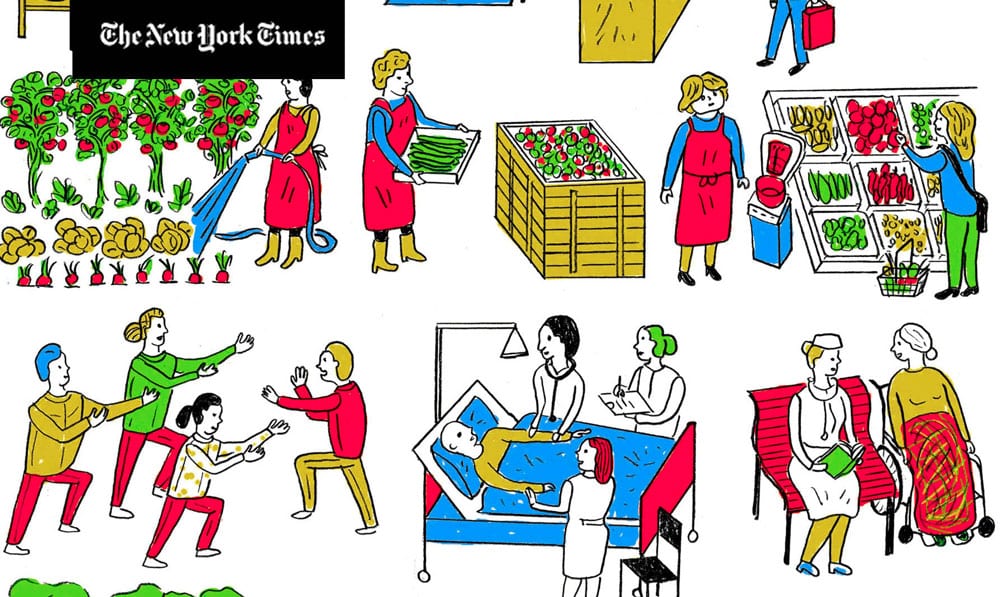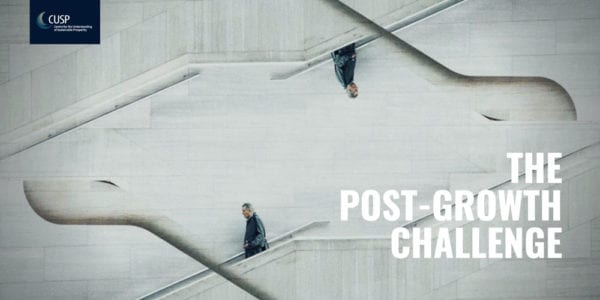Life Beyond Capital
Prof John O’Neill, University of Manchester
CUSP essay series on the Morality of Sustainable Prosperity | No 6

People’s relations with each other and with the environments in which they live have been increasingly articulated in the language of capital. Social relations are described as various forms of social capital. Relations to the environments that matter to people are described in terms of natural capital. This essay challenges this growing dominance of the language of capital. The appeal to natural capital is premised on a misunderstanding of prosperity that fails to properly grasp the place that relationships to people, places and living beings have within a good life. It is in life beyond capital that we are able to fully prosper.
People’s relations with each other and with the environments in which they live have been increasingly articulated in the language of capital. Social relations to family, friends and community are described as various forms of social capital. Our relations to the environments around us, be it woodlands, forests, wetlands, gardens, brownfield sites, or urban parks are described in terms of natural capital. The language of capital penetrates social and environmental policy discussions at local, national and international level. The language of capital is often used to define the very project of sustainability. In the economic literature, sustainability is taken to require that each generation leaves the following generation a stock of capital that is at least as good as that it received, and if possible, improves on that stock of capital. The standard arguments between weak and strong varieties of sustainability concern the mix of capital assets. Proponents of “weak sustainability” are taken to claim that all that matters for sustainability is that the total aggregate level of capital, human-made and natural, must be maintained. Proponents of “strong sustainability” are normally taken to claim that there is some critical level of “natural capital” that must be maintained and which cannot be substituted for by human-made capital. Both agree that policy should aim at maintaining capital.
What is it to conceive of environmental goods as ‘natural capital’? Proponents of natural capital make a number of claims that need to be distinguished.
1. Natural assets and ecosystem services: A basic defining claim that all accounts of natural capital share is that environmental goods, such as wetlands, woodlands and other sites of biodiversity, should be understood as assets that provide benefit streams—ecosystem services—for human well-being. In policy documents this normally comes with a standard list of services: provisioning services, such as inputs into food production; regulating services, such as carbon sequestration and waste assimilation; cultural services, such as recreation or aesthetic enjoyment; supporting services, such as soil formation.1
2. Compensation and substitutability: A second claim concerns substitutability: that losses in one component of capital can be substituted by gains in another, so long as the services they provide maintain or improve well-being. Arguments between proponents of strong and weak sustainability are arguments about the degree of substitutability between natural and human-made capital that is possible. Proponents of “weak sustainability” are taken to claim that a wide degree of substitutability between human-made and natural capital is possible, while proponents of “strong sustainability” are normally taken to claim that there are limits to the substitutability of natural and human-made capital.2 However, the claim that there are limits to the substitutability of natural and human capital is itself consistent with an acceptance of a high degree of substitutability within the sphere of natural capital. A strong sustainability view is consistent with the ‘no net loss’ approaches that have become increasingly prevalent in environmental policy: policy should aim at ‘no net loss’ of natural capital; total aggregate levels of natural capital can be maintained through compensating loss in one component of natural capital with gains in another. So for example, proponents might claim that the destruction of woodland in one area can be compensated for by the development of new woodland or the protection of woodland threatened with destruction elsewhere.
3. Monetisation: A third claim is that the assets that make up natural capital can and should be assigned a monetary value. This claim is often developed through a particular account of the sources of environmental loss—that the loss of environmental goods is the result of the fact that preferences for those goods are not captured in market exchanges. Given this is the case, the solution is to ensure that they are assigned a monetary value—either directly through the definition of tradeable rights to the goods, or indirectly through ascertaining what people would be willing to pay for the goods if there were a market. This monetary can be indirectly ascertained either through “revealed preference methods”, which infer values from behaviour in markets, for example through the way house prices reflect environmental goods, or through “stated preference methods”, such as contingent valuation, which ask people how much they would be willing to pay for a good if there were a market. Monetary valuation is thus extended to a variety of non-market environmental goods such as landscapes, habitats and species.
4. Marketisation: A fourth claim is that markets in environmental goods provide the most efficient and effective way of achieving the aim of no net loss in natural capital. More specifically, offset markets can ensure that, given environmental losses through development, resources are effectively used to compensate for that loss by paying for environmental gains that leave aggregate natural capital at least as good as it was before. Thus in biodiversity offset markets, landowners or environmental organisations who preserve, create, restore or enhance a habitat or site of biodiversity can be assigned credits which can be sold to developers to offset environmental damage to natural capital. Market transactions ensure that there is no net loss of ecosystem services associated with natural capital.
5. Financialisation: A final stronger claim is that environmental goods can be protected by treating them as financial assets. The claim that something can be a financial asset is itself a complex one. In its primary sense it is to claim that it can be treated and valued as a financial income stream. Anything that can produce an income stream—from housing rents and mortgage repayments to hospital car parking charges—can be a financial asset.3 Any financial asset as such has a substitute in any other object or process that has financial returns that are at least as good. Biodiversity offset markets, carbon offset markets and emissions trading are being used as the basis of a new asset class with an associated financial income stream. This treatment of something as a stream for financial returns can provide the basis for a stronger sense in which something can be financialised, that is, the increasing use of financial instruments, such as derivatives, in its governance, particularly the governance of risks associated with the income stream. So, for example, the fact that in 2009 73 percent of the transactions in the European Union Emissions Trading Scheme were in futures markets4 is a mark of the financialisation of emissions trading.
These are five independent claims. The core claim that proponents of natural capital share is the first claim concerning nature as an asset that provides services. This underpins the second claim concerning substitutability. Monetisation, marketisation and financialisation presuppose these two basic claims, but it is possible to maintain these basic claims without being committed to monetary valuation, offset markets or financialisation. Similarly, it is possible for example to defend monetary valuation and reject offset markets as effective ways to protect biodiversity, or to defend offsets but to believe the involvement of finance brings risks to the environment that are best avoided.
This paper criticises the view that nature should be understood simply as capital. The central object of criticism will be the first two core claims outlined. I suggest that there are some parallels between what is wrong with understanding social relations as capital and understanding relations to nature in terms of capital. While the central object of criticism will be the two core claims, I also make some critical responses to monetisation, marketisation and financialisation. In developing these criticisms, I retain a focus on human well-being. I argue that the concepts of natural capital and ecosystem services cannot capture all the dimensions of value that are central to human well-being.
In retaining this focus, I will not consider here arguments that appeal to normative considerations independent of human well-being. I do not examine here in detail appeals to the moral standing of non-human beings. Nor do I consider appeals to the possible impersonal value of goods such as biodiversity or beauty—that is, whether their loss is bad in itself even if it is not bad for the well-being of any being.5 These lines of argument are important and deserve their own discussion. My aim in this paper is more modest. I argue that there are dimensions of good that the concept of natural capital cannot capture, even if we are concerned only with human well-being and prosperity. The appeal to natural capital is premised on a misunderstanding of prosperity that fails to properly grasp the place that relationships to people, places and living beings have within a good life.
Natural assets, ecosystem services and substitutability
A core claim of proponents of natural capital is that environmental goods, like woodlands, wetlands and other sites of biodiversity, should be treated as assets that are valued for the ecosystem services they provide for human beings.
What is it to value goods for their services? A starting point for an answer is this general characterisation of goods as services in economic theory offered by Ayres and Kneese: ‘Almost all of standard economic theory is in reality concerned with services. Material objects are merely the vehicles which carry some of these services, and they are exchanged because of consumer preferences for the services associated with their use or because they can help to add value in the manufacturing process.’6
There are three features of the use of the concept of services in economic theory that this passage highlights.
1. Instrumental value: Services are instrumental—the means to an independently specified end.
2. Mere vehicle: The object is valued ‘merely as a vehicle’ that carries those services.
3. Scope: The independent end for which economic goods provide services are consumer preferences, either through direct use or through indirect contributions to manufacturing processes.
The concept of ecosystem services might be thought to differ from this economic characterisation of services by widening the scope claim through its introduction of regulating services, cultural services and supporting services. Whether this is the case or not I leave aside here. What the concept of ecosystem services retains are the instrumental value and mere vehicle claims. To treat environmental goods as natural capital is to treat them as an instrumental means to an independent end—human well-being understood in terms of preference satisfaction—where the goods are merely vehicles for the services they provide.
Consider the second claim. What is it to value a good merely as a vehicle for services? For what class of objects and beings is such a valuation justified? A good place to start to answer these questions is the distinction between de dicto and de re valuations. Hare usefully illustrates the distinction through a joke concerning Zsa Zsa Gabor:
Zsa Zsa: “Ah! People misunderstand me! They think that I am just a creature of leisure, that I do nothing useful, but they are wrong. I am constantly finding new ways to do good for people.”
Interviewer: “Like what?”
Zsa Zsa: “I have found a way of keeping my husband young and healthy, almost forever.”
Interviewer: “Eternal youth… that is quite a discovery! How do you do it?”
Zsa Zsa: “I get a new one every five years!”7
The joke turns on a shift between de re and de dicto readings of Zsa Zsa’s valuations. When she claims she is doing good in finding a way to keep her husband young and healthy, we assume that there is a particular person, her husband, whose youth and health she values and promotes. We assume she is valuing de re:
There is a particular human being, Zsa Zsa’s husband, and Zsa Zsa values and promotes his youth and health.
It turns out that we read her claim wrongly. Zsa Zsa simply wants it to be the case that, whoever falls under the description ‘Zsa Zsa’s husband’, he is young and healthy. She is valuing de dicto:
Zsa Zsa values and promotes that there is someone who is the husband of Zsa Zsa and, whoever he is, that he is young and healthy.
As the formulations above suggest, an initial way of capturing the ambiguity is in terms of the scope of quantifiers:
De re reading: ∃x (x is the husband of ZZG and ZZG values the health of x).
De dicto reading: ZZG values ∃x (x is the husband of ZZG and x is healthy).
Under the de re reading Zsa Zsa values a particular individual. Under the de dicto reading she values whatever individual falls under a description.
The distinction is helpful to understand what is at stake in the claim that objects should be valued merely as vehicles for services. To value an object simply as a vehicle for services is to value the object de dicto and not de re. One values whatever provides the services. The object, as Ayres and Kneese put it, is merely a vehicle for the services. As such it can be substituted by another object, if that object provides the same services, without any loss of value. If particular sites of biodiversity are valued de dicto then they are substitutable in just the way Zsa Zsa Gabor husbands are substitutable. If one site falls under the appropriate description it will be in principle substitutable by any other site that falls under the same description.
It is important to note immediately that de dicto valuation is itself consistent with considerable limits to the substitution of one object for another. One contingent source of non-substitutability is uniqueness, where only one object falls under the relevant description. For the biologist who does not value, de re, any particular Pinta island tortoise, but does value, de dicto, that there exist a healthy population of Pinta island tortoises, the last Pinta island tortoise, Lonesome George, will not be replaceable. A second and, in the context of substitutability of sites of biodiversity, more pressing limit to substitutability is that the substitute must fall under the same description. In the case of sites of biodiversity it will typically simply not be possible to create a new site that has the identical biodiversity properties. Hence, a great deal of the debate on substitutability will turn on the description under which substitution takes place. One site can be substituted for another under one description—for example as a mixed woodland—but not under another—for example a woodland which contains a specific range of species types. Correspondingly, much of the criticism of the possibility of biodiversity offsetting quite properly is concerned with the ways in which the equivalence of two sites of biodiversity are characterised.8 The language of services, by abstracting from the specific biophysical properties of places, often fosters a general description that fails to acknowledge specific qualities that matter to people.
De re valuation places deeper restrictions on the possibility of substitution without loss. It is the particular object that is valued, not simply whatever object falls under a description. If a site of biodiversity is valued de re it cannot be substituted by another object simply because it falls under the same description. It is a particular place that is valued, not any place that falls under the appropriate description. The policies of biodiversity offsetting and no net loss rely on an assumption that the goods should be valued de dicto and not de re. Is this assumption justifiable?
What is the scope of objects to which de re and de dicto valuation is appropriate and why? De re values do look to be the attitudes that are appropriate to particular individuals who stand in particular relationships to us. Zsa Zsa Gabor has not found a novel ‘way of doing good for people’ by replacing her old husband with a new one. However, there is a large class of objects for which de dicto valuation is appropriate. A person values whatever falls under a description. Tools are typically valued de dicto. What matters with a tool is typically that it does a job. It is ‘merely a vehicle for the services’ it provides. Other tools will do if they do the same job. There are exceptions—the hammer that was handed down to me by my father that I value de re. However, these are exceptions. There is a large range of everyday fungible goods for which de dicto valuation is quite appropriate. Some environmental resources are typically valued de dicto. Consider sources of energy in so far as they matter for the needs they are able to satisfy, such as transport, warmth, sustenance and health.9 The source of energy is valued as a vehicle for the provision of needs. Insofar as the concern is simply with the consumption of energy to meet needs, what is typically valued is that there is a source of energy, not any particular source. That sources of energy are valued de dicto is a precondition of sustainability allowing, for example, the substitutability of sources of energy with high greenhouse gas emissions, such as coal and oil, by sources that have lower emissions, such as wind power. Why shouldn’t all environmental goods similarly be treated simply de dicto?
The question of substitutability is Janus-faced in discussions of sustainability. On the one hand the substitutability of environmentally damaging goods and resources by goods and resources that have lower impacts is a condition of sustainability. However, on the other hand, sustainability also typically requires that there are places, habitats and beings which are not substitutable. So, for example, where a new source of energy production such as a dam affects a particular valued place or habitat, it can involve the loss of a good for which there is no substitute. One source of non-substitutability is the existence of goods for which de re rather than de dicto valuation is appropriate.
Why are many environmental goods properly valued de re? What is the scope of the goods for which such valuation is appropriate? To answer these questions, it is worth turning to the contribution that relations to particular persons, places and objects make to human well-being. Relations to particulars—people, objects and places—are central components of human well-being. Doesn’t this claim return us to instrumental relationships to persons and non-human goods where these are understood as mere vehicles that provide services? It does not. I noted earlier that there were three components to the standard economic concept of services: services are instrumental means to an independently specified end; objects are mere vehicles for the services; and the end is well-being, typically conceived as preference satisfaction. The ways in which relations to particular persons, places and objects matter centrally to human well-being cannot be captured by this economic concept of services. Relations to particulars are not simply the instrumental means to well-being specified independently of these relations. They are, rather, constitutive of well-being.
A distinction needs to be drawn between two ways in which something might be said to contribute to an end: as an external causal means to an end; as a constituent of that end.10 Consider again social relationships. Social relationships, like relationships to environmental goods, are often described as forms of capital—social capital. Social relationships bring a number of independent benefits to individuals—higher income, improved health, protection against risk, better employment. All of this might be true. However, a person who valued their relationships purely for benefits like this would miss the central place that close relationships to friends and family have in life. Friendships are not simply an external causal means to independent goods. Our friends and our relationships with our friends are valuable as ends in themselves. They are part of what makes a good life. They contribute to our lives not as external causal determinants but as constituents of a good life.
Similar claims can be made with respect to relationships to places and non-human beings that matter to the lives of people.11 Such relationships to particular places are constitutive of the lives of people. They are relationships not to natural capital—to goods that are merely external means to well-being. Rather, relationships to particular places and beings are valued for their own sake. They form part of the lives of persons and communities. As Goodin notes, they provide a context through which people can make ‘some sense and patterns to their lives’12. The relationships involve de re attitudes and values. Attachment to particulars matters to people. Just as it is an error to treat social relationships like friendship merely as forms of ‘social capital’, so it is an error to treat relationships to particular places and environments simply as forms of ‘natural capital’ that deliver external benefits. The existence of such external benefits of relationships to people and places are no doubt true, but the language of capital and services fails to recognise the ways that these relationships are constitutive of a good life.
Monetisation
The way that particular places matter can be illustrated by the ways in which individuals properly protest at attempts to treat those relationships as if they were just a matter of external benefits. Those protests are often apparent in the rejection of the monetisation and marketisation of environmental goods. Consider the following response to a demand to put a monetary value on a good from a member of an adavasi community in the Narmada valley threatened by the creation of a dam:
‘You tell us to take compensation. What is the state compensating us for? For our land, for our fields, for the trees along our fields. But we don’t live only by this. Are you going to compensate us for our forest?…Or are you going to compensate us for our great river—for her fish, her water, for vegetables that grow along her banks, for the joy of living beside her? What is the price of this? …How are you compensating us for fields either—we didn’t buy this land; our forefathers cleared it and settled here. What price this land? Our gods, the support of those who are our kin—what price do you have for these? Our adivasi (tribal) life—what price do you put on it?’13
Two points are worth making here. The first is that what is at stake is not simply the loss of ecosystem services, but a particular place that is valued as such. The passage does refer to things that appear in standard lists of ‘ecosystem services’, for example, the ‘provisioning services’ of fish, and water for the soil. However, it is not simply the services as such that make the loss of the place to flood so traumatic. What matters is the loss of this particular place in which the past of a community is embodied and which is constitutive of social relations and way of life in the present. The loss of the place threatens the disintegration of relationships and practices that are central to the well-being of its members.
Second, one way that the value of the relationship to place and community is expressed is to refuse to place a monetary value on it. The question ‘what price?’ in the passage is rhetorical. The use of money is not some exercise in the measurement of well-being. It has a social meaning. Certain relationships are constituted by a refusal to put monetary values on them.14 These include relationships to valued particulars like relations to kin or to a particular place that embodies the life of a community. Part of what grounds the refusal to accept a monetary value on the good is the refusal to treat the particular place as a fungible good that can be replaced by others. To place monetary values on the goods, to offer a price that would be acceptable for their loss, would be to treat the goods as exchangeable.
Marketisation and offsets
These problems are also evident in responses to offset markets. The use of direct market mechanisms in ecosystem services has become increasingly prevalent as a policy choice. The markets can take various forms. Developers can directly pay for projects that offset the environmental losses they cause. Landowners or environmental organisations can be assigned credits for preserving, restoring or enhancing the environmental value of a site or creating a new site of environmental value, credits which developers can buy to offset environmental losses caused by a development. Market transactions ensure that there is no net loss of environmental benefits. Total natural capital is maintained. Offsetting markets have been around for a number of years in Australia and the United States.15 A policy of ‘no net loss’ through offsetting is now central to EU and UK biodiversity plans.16 The policy is invoked in justifications of new projects that cause environmental damage such as the planned High Speed 2 train line in the UK17 and mining projects by Rio Tinto Zinc in Madagascar18.
Offset markets in biodiversity as a means to achieving ‘no net loss’ assume that the places of biodiversity lost are valuable de dicto and not de re. The practices assume that there should exist an aggregate number of sites of different kinds of biodiversity. Given a particular description of the biodiversity qualities of a site, α1…. α n, so long as a required number of sites fall under the appropriate description the policy aim is met. A de dicto valuation is assumed:
P values ∃x (x is a site of biodiversity with
qualities α1…. α n).
As I noted earlier, one major question about substitutability concerns under what description of the site of biodiversity substitution is made. If the description of the qualities of the site is rendered general and abstract enough, then substitutability is not difficult. Given more specific descriptions it is exceptionally difficult. The politics of offsetting debates in part turn on what counts as an acceptable substitute under what description. However, there is a further source of opposition to offsetting the destruction of sites of biodiversity for the purposes of some development. Opposition is often moved by an attachment to particular places. The site is valued de re:
∃x (x is a site of biodiversity with qualities α1….
α n and P values x).
It is a particular place that is valued.
Consider for example the current arguments over Smithy Wood, an 800 year old woodland of twenty acres near Sheffield in the UK, that is threatened by the construction of a new motorway service area. The promise is that the loss will be offset by the creation of ‘up to 600 acres of new and existing woodland’ that would form part of a new ‘community’ woodland. Why the local opposition? Part of the opposition concerns issues as to whether the biodiversity that comes with an ancient woodland could be replicated. The new woodland would not contain the same mix of 121 species of plant as the old woodland.19 However, the problem also lies in the fact that no new site could replicate the particular valued history of the woodland that would be lost in Smithy Wood. Even if it were possible to keep a woodland with the same features, something would be lost. It is this particular place with the history that is embodied in it that matters. The de re value cannot be compensated with the gain of woodland elsewhere.
To make these points is not to say that de re values are a kind of trumps in normative arguments. Nor is it to deny the need for some kinds of development that involve the loss of particular places to which individuals have a significant relationship which is central to their well-being. Where other vital needs are at stake, developments might sometimes be justifiable. A motorway service station is a typical example of a trivial development in which there are no vital needs at stake. The simple adding up of saved journey times for the new high-speed train line set against the loss of particular places of importance to the everyday lives of people and communities is another.20
Other examples see vital needs themselves being put at risk through offsetting markets. The forest offset scheme used to justify the loss of forest to mining in Madagascar involves the loss of access to land required to meet basic livelihood needs.21 However, not all development need be of this kind. Where other vital needs are at stake some developments might be justifiable. However, even where this is the case, it is a myth that any such losses can be offset to achieve ‘no net loss’. A relationship to a particular person or place that is central to the life of a community or person will have no substitute. A loss is a loss to the life of a person and that loss cannot be compensated for by some gain elsewhere. The policy of ‘no net loss’ through offsets disguises the very real losses that occur.
Financialisation
Natural capital in its basic sense—nature understood as a stream of services for human well-being—along with its monetisation and marketisation are conditions for the financialisation of nature. However, financialisation is a distinct development. Financialisation starts from a view of assets as a stream of benefits in a more specific sense—assets that have value as a stream of financial returns. Financial management is in part the art of putting together a portfolio of assets that are marked by a particular rate of return and level of risk. Ecosystem services become a particular asset class with their own rate of return and levels of associated risk. For the financial world it is claimed to offer a growing asset class22 and one with an estimated ‘total investment potential of USD 200 – 400 billion in the conservation market between [2016] and 2020’23. Biodiversity offset markets, along with carbon markets and water quality trading, are presented as the main sources for these new investment opportunities.24 The proponents of the use of finance take this to provide opportunities for increased funding of conservation projects through the financial streams associated with different ecosystem services.25 The development of the financialisation of nature deserves much more detailed treatment than I can give it here. Here I confine myself to two critical observations.
The first concerns substitutability. The financialisation of nature extends the scope of substitutability. One asset can be substituted by any other that offers a similar or better financial return. A feature of financialisation is that the nature of the underlying asset is of little matter. Financialisation distances decisions still further from the particular features of the places that matter to those who live in and with them. In particular, financialisation moves policy still further from the specifics of location and time that make a particular place of value. As Defoe noted of the development of the new world of finance in the 17th and 18th century financial revolution, ‘it has no Whereness, or Whenness, Scite, or Habit’26.
The second observation concerns the nature of the asset class created. An object or flow of services becomes a financial asset to the degree that it offers a future income stream which will warrant investment in it. In financial markets, nature has to be able to pay. Offsets are a way in which it can be made to do so. This is their promise to nature conservation organisations. However, a perverse feature of this financialisation is that to act as an income stream at all, offsets require developments elsewhere that are destructive of environmental goods. It is these developments which give habitats and other natural resources their economic value as offsets. The economic value of the forest as a carbon offset depends upon the continued existence of excessive carbon emissions. Without those emissions the forest as carbon sink is economically valueless. Without the destruction of biodiversity, a habitat as a biodiversity offset is economically worthless. Nature conserving activities become dependent upon nature destructive activities. The relationships of dependence are realised as relationships between owners or managers of natural resources on the one hand and developers on the other. The future income stream of the manager depends on the activities of the developer. Where the manager is a conservation organisation it creates one of the many kinds of dependence that are increasingly seen globally, where many major NGOs such as Conservation International, Flora and Fauna International, Kew Gardens, BirdLife International and the International Union for Conservation of Nature are increasingly recipients of financial transfers from developers involved in environmentally destructive activities.27 Thus, for example, BirdLife International becomes a partner with Rio Tinto in the design and management of offset programmes to ensure ‘Net Positive Impact’ from its mining operations on biodiversity in Madagascar, offset programmes that result in a loss of livelihood to communities dependent on forests.28 Such dependencies are not simply the result of incidental actions of particular organisations. They are structural outcomes of the financialisation of nature in which environmental goods as an asset class created through offsets are themselves rendered dependent on the continued existence of environmental damage.
Credit Suisse in a 2016 report on conservation finance offer the following observation on barriers to the growth of markets in conservation: ‘One of the biggest barriers for further conservation market growth is a philosophical one. Many environmental interest groups fear the perceived “commodification” that comes with translating conservation projects into financial terms. At root, many players are just not really comfortable with the idea of taking elegant, bespoke projects and reducing them to fungible cash flows and products.’29 It is not often that philosophical objections appear as a barrier to markets that financial firms consider worth their worry. They do so only to the extent that they are articulated by organised forms of opposition. The problem is not one of not being ‘comfortable with the idea’. Rather, resistance can start from a well-founded set of objections to financialisation. Financial markets fail to capture what is at stake in the loss of places, habitats and ecosystems that matter to people and communities. They create perverse forms of dependence of the conservation of environmental goods on environmental damage elsewhere. The treatment of nature as capital is not a solution to the problems of environmental loss. Rather, it is part of the problem.
Conclusion
My central purpose in this paper has been to articulate and defend a particular line of argument against the increasing use of ‘natural capital’ as a way of understanding our relations to the environmental goods that matter to people. My central argument has been that it fails to recognise the sources of non-substitutability of different goods and places. In particular it fails to recognise the importance of relations to particulars in the lives of people and communities. Places are valued de re and matter as such.
In articulating this point I am not claiming that this is the only or even the most important criticism of natural capital. There are other lines of argument that deserve more detailed consideration than I am able to give here.30 For example, there are justice based arguments concerning the ways in which monetisation, marketisation and financialisation distribute harms and risks of harm. There are arguments about the ways in which one language valuation dominates public discourse, leading to procedural and recognitional injustice.31 There are arguments about the ways in which the language of natural capital fails to capture the well-being of non-humans. My aim here has been narrower—that even within the constraints of thinking about the ways in which nature and environmental goods matter to human well-being, the language of natural capital fails. People’s everyday lives are lived among the particular people and places that matter to them. They still live lives outside the ever expanding domains of capital. Our environmental and social crises require not the expansion of the worlds of capital, but resistance to that expansion and the growth of spheres of life beyond capital.
Doing so also requires resistance to a particular understanding of prosperity. One prominent understanding of the concept of ‘prosperity’ is that expressed in the strange doctrine of ‘prosperity theology’—that faith in God will bring financial rewards in this world. One striking expression of prosperity theology is to be found in a translation of a passage from Ecclesiastes by the American Bible Study for the Good News Bible. The passage in question is translated thus in the King James Bible: ‘Cast thy bread upon waters: for thou shall find it after many days’32. The Good News Bible, which promises ‘to present the Biblical content and message in standard, everyday, natural English’33, offers in its place the following rendition: ‘Invest your money in foreign trade, and one of these days you will make a profit’34. The virtues of generosity and the central place of reciprocal relationships in human life are redescribed in terms of the promise of monetary wealth and the commercial relationships of business. The translation captures what is wrong with a picture of social relationships understood simply as capital. The exercise of virtues like generosity and the relationship of reciprocal giving to others are central components of a good life—they are not simply the external means to goods of monetary wealth. Similar points can be made about the language of natural capital. It offers a version of a ‘prosperity ecology’ that is akin to ‘prosperity theology’. Nature is valued simply as an external causal means to the provision of services. ‘Prosperity ecology’ fails to capture central ways in which relationships to particular places and beings matter in human lives. Those relationships are central components of good lives. What this ‘prosperity ecology’, like prosperity theology, gets wrong is an understanding of what it is to live a good human life. Both fail to grasp the nature of prosperity properly understood and the place of relationships to people, places and living beings within those lives. It is in a life beyond capital that we are able to fully prosper.
Notes
1 TEEB 2010: The Economics of Ecosystems and Biodiversity: Mainstreaming the Economics of Nature: A synthesis of the approach, conclusions and recommendations of TEEB (p.7).
Available at: www.teebweb.org/wp-content/uploads/Study%20and%20Reports/Reports/Synthesis%20report/TEEB%20Synthesis%20Report%202010.pdf
2 For discussions see: Solow R. M. 1993 ‘Sustainability: An Economist’s Perspective; in Dorfman N. and R. Dorfman (eds.) 1983: Economics of the Environment: Selected Writings. New York: Norton; Beckerman W. 1994: ‘Sustainable Development’: Is It a Useful Concept?’, Environmental Values 3: 191-209; Daly H. E. 1995: On Wilfred Beckerman’s critique of sustainable development, Environmental Values 4, 1: 49-55; Jacobs M. 1995: Sustainable Development, Capital Substitution and Economic Humility: a Response to Beckerman, Environmental Values 4, 1: 57-68; Dobson A. 1996: Environmental Sustainabilities: An Analysis and a Typology, Environmental Politics 5: 401-428; Holland A. 1997: Substitutability—or, why strong sustainability is weak and absurdly strong sustainability is not absurd, in: Foster J. (ed. ) 1997: Valuing Nature. London: Routledge.
3 See Sayer A. 2015: Why We Can’t Afford the Rich. Bristol: Policy Press
4 Kossoy A. and P. Ambrosi 2010: State and Trends of the Carbon Market 2010. Washington: World Bank (p.2).
5 On impersonal values see Brink. D. 1989: Moral Realism and the Foundations of Ethics. Cambridge: Cambridge University Press. Temkin claims equality is an impersonal value as are other ideals, such as freedom and justice in Temkin L. 2012: Rethinking the Good: Moral Ideals and the Nature of Practical Reason.Oxford: Oxford University Press (ch.12 and passim). G. E. Moore claimed beauty was an impersonal value in Moore. G. E. 1903: Principia Ethica. Cambridge: Cambridge University Press (p.85-87). If biodiversity has intrinsic value in the sense of value independent of its instrumental value for individual living organisms, then it is an impersonal value. For critical discussion of the claim that biodiversity has impersonal value see Kraut R. 2012: Against Absolute Goodness. Oxford: Oxford University Press (ch. 23).
6 Ayres R. U. and Kneese A. V. 1969: Production, Consumption, and Externalities, The American Economic Review, 59: 282-297 (p.284).
7 Hare C. 2007: Voices from Another World: Must We Respect the Interests of People Who Do Not, and Will Never, Exist?, Ethics 117: 498-523 (p. 514)
8 For discussion of the problem of equivalence in ecosystem offsetting markets see Carver L. and Sullivan S. (forthcoming): How Economic Contexts Shape Calculations of Yield in Biodiversity Offsetting, Conservation Biology; Sullivan S. 2013: After the Green Rush? Biodiversity Offsets, Uranium Power and the Calculus of Casualties in Greening Growth, Human Geography 6: 80-101. For a more detailed discussion of the concept of substitutability and the different senses in which things can substitute for others see O’Neill J. 2015: Sustainability, in: Moellendorf D. and H. Widdows (eds.) 2015: The Routledge Handbook of Global Ethics. London: Routledge.
9 See Brand-Correa L. and J. Steinberger 2017: A Framework for Decoupling Human Need Satisfaction from Energy Use, Ecological Economics 141: 43-52.
10 The distinction is central to the Aristotelian accounts of well-being and practical reason. See Cooper J. 1975: Reason and Human Good in Aristotle. Cambridge, Mass.: Harvard University Press; and Wiggins D. 1980: Deliberation and Practical Reason, in: Rorty A.O. (ed. ) 1980: Essays on Aristotle’s Ethics. Berkeley: University of California Press.
11 See O’Neill J. 1993: Ecology, Policy and Politics: Human Well-Being and the Natural World. London: Routledge (p.23-24); and James S. 2016: Ecosystem Services and the Value of Places, Ethical Theory and Moral Practice 19: 101-113.
12 Goodin R. 1992: Green Political Theory. Cambridge: Polity Press (p.37).
13 Bava Mahalia 1994: Letter from a Tribal Village, Lokayan Bulletin 11.2/3, Sept-Dec.
14 Raz J. 1986: The Morality of Freedom, Oxford: Clarendon (p.345ff); O’Neill J. 1993: Ecology, Policy and Politics: Human Well-Being and the Natural World, London: Routledge (p.118–122); O’Neill J., Holland A. and A. Light 2008: Environmental Values. London: Routledge, (p. 77-79)
15 Kiesecker J., Copeland H., Pocewicz A., Nibbelink N., Mckenney B., Dahlke J., Holloran M. and D. Stroud 2009: A Framework for Implementing Biodiversity Offsets, Bioscience 59:77-84. Madsen B., Carroll N., Kandy D. and G. Bennett 2011: State of Biodiversity Markets. Washington, DC: Forest Trends. Available at: http://www.ecosystemmarketplace.com/reports/2011_update_sbdm. UNEP 2011: Towards a Green Economy: Pathways to Sustainable Development and Poverty Eradication. Available at www.unep.org/greeneconomy. BBOP 2012: No Net Loss and Loss-Gain Calculations in Biodiversity Offsets. Washington, D.C.: Business and Biodiversity Offsets Programme. Available at: http://www.forest-trends.org/documents/files/doc_3103.pdf.
16 Communication from the Commission to the European Parliament, The Council, The Economic And Social Committee And The Committee Of The Regions 2011: Our Life Insurance, Our Natural Capital: An EU Biodiversity Strategy to 2020. Avalaible at: http://eur-lex.europa.eu/LexUriServ/LexUriServ.do?uri=COM:2011:0244:FIN:EN:PDF. Defra 2011: Biodiversity 2020: A strategy for England’s wildlife and ecosystem services. Avalaible at: https://www.gov.uk/government/uploads/system/uploads/attachment_data/file/69446/pb13583-biodiversity-strategy-2020-111111.pdf. Defra 2012: Biodiversity Offsetting Pilots: Technical Paper: the metric for the biodiversity offsetting pilot in England. Available at: https://www.gov.uk/government/uploads/system/uploads/attachment_data/file/69531/pb13745-bio-technical-paper.pdf. DEFRA 2013: Biodiversity Offsetting in England Green Paper. Available at: https://consult.defra.gov.uk/biodiversity/biodiversity_offsetting/supporting_documents/20130903Biodiversity%20offsetting%20green%20paper.pdf.
17 High Speed Two (HS2) Limited 2015: HS2 London—West Midlands: No net loss in biodiversity calculation. Available at: https://www.gov.uk/government/uploads/system/uploads/attachment_data/file/490928/No_net_loss_in_biodiversity_calculation_-_methodology_and_results_v2.pdf.
18 Kill J. and G. Franchi 2016: Rio Tinto’s biodiversity offset in Madagascar, World Rainforest Movement and Re-Common; Seagle C. 2012: Inverting the impacts: Mining, conservation and sustainability claims near the Rio Tinto/QMM ilmenite mine in Southeast Madagascar, The Journal of Peasant Studies 39: 447-477.
19 Barnes S. 2017: For an Ancient Woodland near Sheffield, Spring will Herald a Carpet of Bluebells—or the Construction of a Giant Car Park, The Sunday Times, 19 March 2017.
20 Cf. Wiggins D. 2005: An Idea We Cannot Do Without: What Difference Will It Make (eg. to Moral, Political and Environmental Philosophy) to Recognize and Put to Use a Substantial Conception of Need?; Royal Institute of Philosophy Supplement 57: 25-50.
21 Kill and Franchi op.cit.
22 NatureVest and EKO Asset Management Partners, 2014: Investing in Conservation: A Landscape Assessment of an Emerging Market. Available at: http://encouragecapital.com/wp-content/uploads/2015/09/EKO-TNC-InvestingInConservation_Report1.pdf.
23 Credit Suisse and the McKinsey Center for Business and Environment 2016: Conservation Finance—From Niche to Mainstream: The Building of an Institutional Asset Class (p.10). Available at: https://assets.rockefellerfoundation.org/app/uploads/20160121144045/conservation-finance-en.pdf. The extent to which nature conservation is being financialised is contested. For a sceptical view, see Dempsey J. and D. Suarez 2016: Arrested Development? The Promises and Paradoxes of “Selling Nature to Save It”, Annals of the American Association of Geographers,106: 653-671.
24 Credit Suisse 2016: Levering ecosystems: A business-focused perspective on how debt supports investments in ecosystem services (p.7.). Available at: https://www.credit-suisse.com/media/assets/corporate/docs/about-us/responsibility/banking/levering-ecosystems.pdf.
25 See for example the RSPB report: Comerford E., Molloy D. and P. Morling 2010: Financing nature in an age of austerity. Available at: http://www.rspb.org.uk/Images/Financingnature_tcm9-262166.pdf.
26 Defoe D. 1710: An Essay upon Publick Credit. Available at: http://quod.lib.umich.edu/e/ecco/004843879.0001.000/1:3?rgn=div1;view=fulltext. Defoe himself was a defender of finance against the civic republican critics, but the underlying point about the distancing from attachment to particulars retains its power.
27 Conservation International, Flora and Fauna International, Kew Gardens, BirdLife International and the International Union for Conservation of Nature are all partners of Rio Tinto in Madagascar (Seagle, op.cit., p.453). Another example is the relationships of Shell and the Smithsonian Institute in Peru and Gabon (Seagle, op.cit., p.453). See also for example the joint 2013 report of the International Union for Conservation of Nature and the International Council on Mining and Metals Independent Report on Biodiversity Offsets. Available at: https://www.iucn.org/downloads/icmm_biodiversity_offsets_rpt.pdf.
28 For details of the partnership between Rio Tinto and BirdLife International and its role in the development of Rio Tinto’s offsetting pilot project in Madagascar, see BirdLife International 2011: Tsitongambarika Forest, Madagascar. Biological and Socio-economic Surveys, with Conservation Recommendations. Cambridge, UK: BirdLife International. Available at http://www.birdlife.ch/sites/default/files/documents/BirdLife-2011-Tsitongambarika-book-En.pdf. On the impacts on the local community, see Kill and Franchi op.cit. , and Seagle op.cit..
29 Credit Suisse and the McKinsey Center for Business and Environment 2016: Levering ecosystems: A business-focused perspective on how debt supports investments in ecosystem services (p.8)
30 For an outline of some of these see O’Neill J. 2016: Markets, Ethics and Environment, in: Gardiner S. and A. Thompson (eds) 2016: Oxford Handbook of Environmental Ethics. Oxford: Oxford University Press.
31 See Martinez-Alier J. 2002: Environmentalism of the Poor. Cheltenham: Edward Elgar, and O’Neill J. 2017: The Price of an Apology. Cambridge Journal of Economics 4: 1043-1059.
32 Ecclesiastes, 11.1, The Holy Bible: Authorized King James Version (Collins: London, 1957)
33 Good News Bible (Collins: Glasgow, 1976) Foreword.
34 Ecclesiastes, 11.1 Good News Bible (Collins: Glasgow, 1976). My thanks to my friend Paul Lancaster for pointing out this translation.
Acknowledgements
The arguments in this paper owe a great deal to two recent European projects: BIOMOT and EJOLT. Particular thanks are owed to Paul Knights, Michael Scott and Ada Wossink for some of the ideas developed here. Earlier versions of some of the arguments here were presented at the Biosymposium 2015: the Functions and Values of Biodiversity, Oxford University, January, 2015. My debate with Dieter Helm at that meeting was rewarding and conducted in the spirit of open inquiry that should inform such conversations. Versions of the arguments were also presented at the following meetings: NMBU, Oslo, September 2017; Der Wert der Natur University of Frankfurt, December 2016; Relational Values and Nature: Implications for Science and Policy in San Sebastian, May 30-June 1 2016; Edinburgh Science Festival, April 2015; Financialisation of Nature University of Sussex, March 2015; Nature is not for sale London, June 2014. I would like to thank the many participants in these events for their valuable comments. Finally I would like to thank Richard Christian, Will Davies, Giulia Franchi, Linda Geßner, Mike Hannis, Tim Jackson, Jutta Kill, Darrel Moellendorf, Andrew Sayer, Yvette Solomon, Sian Sullivan and Arild Vatn for their helpful comments on earlier drafts of this paper.
About the author
John O’Neill is Professor of Political Economy at the University of Manchester. He has written widely on philosophy, political economy and environmental policy. His books include Markets, Deliberation and Environment (Routledge, 2007), The Market: Ethics, Knowledge and Politics (Routledge, 1998) and Ecology, Policy and Politics: Human Well-Being and the Natural World (Routledge, 1993). He is co-author of Environmental Values (Routledge, 2008) with Alan Holland and Andrew Light.
The full paper is available for download in pdf (1MB). | O’Neill J 2017. Life Beyond Capital. CUSP Essay Series on the Morality of Sustainable Prosperity, No 6. Guildford: Centre for the Understanding of Sustainable Prosperity.
Essay Series















